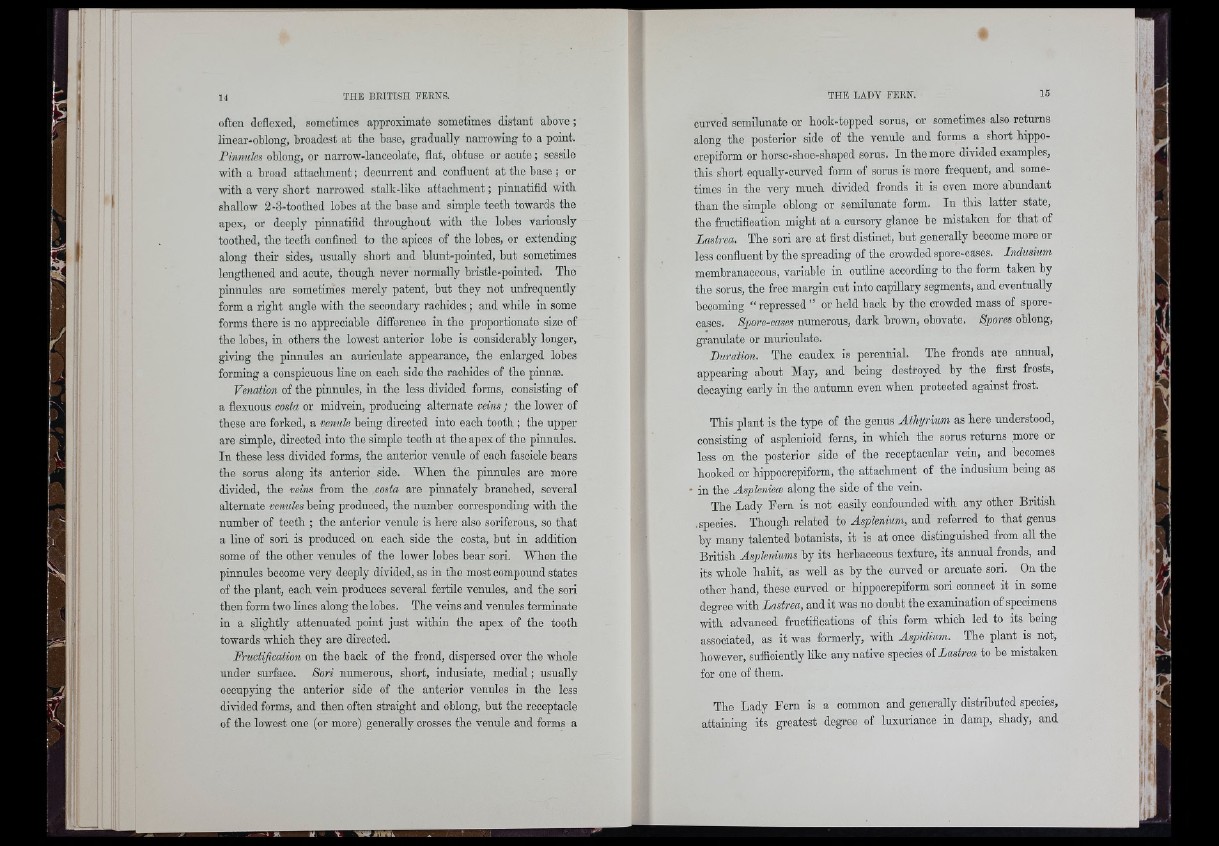
often defloxed, sometimes approximate sometimes distant above ;
linear-oblong, broadest at tbe base, gradually narrowing to a point.
Pinnules oblong, or narrow-lanceolate, flat, obtuse or acute ; sessile
witb a broad attacbment ; doourrent aud confluent at tbe base ; or
with a very short narrowed stalk-like attachment ; pinnatifid with
shallow 2-3-toothed lobes at the base and simple teeth towards the
apex, or deeply pinnatifid throughout with the lobes variously
toothed, the teeth confined to the apices of the lobes, or extending
along their sides, usually short and blunt-pointed, but sometimes
lengthened and acute, though never normally bristle-pointed. The
pinnules are sometimes merely patent, but they not unfrequently
form a right angle with the secondary rachides ; and while in some
forms there is no appreciable difference in the proportionate size of
the lobes, in others the lowest anterior lobe is considerably longer,
giving the pinnules an auriculate appearance, the enlarged lobes
forming a conspicuous line on each side the rachides of the pinnæ.
Venation of the pinnules, in the less divided forms, consisting of
a flexuous costa or midvein, producing alternate veins ; the lower of
these are forked, a venule being directed into each tooth ; the upper
are simple, directed into the simple teeth at the apex of the pinnules.
In these less divided forms, the anterior venule of each fascicle bears
the sorus along its anterior side. When the pinnules are more
divided, the veins from the costa are pinnately branched, several
alternate venules being produced, the number corresponding with the
number of teeth ; the anterior venule is here also soriferous, so that
a Une of sori is produced on each side the costa, but in addition
some of the other venules of the lower lobes bear sori. When the
pinnules become very deeply divided, as in the most compound states
of the plant, each vein produces several fertile venules, and the sori
then form two lines along the lobes. Tbe veins and venules terminate
in a slightly attenuated point just within the apex of the tooth
towards which they are directed.
Pructification on the back of the frond, dispersed over the whole
under surface. Sori numerous, short, indusiate, medial ; usually
occupying the anterior side of the anterior vemdes in the less
divided forms, and then often straight and oblong, but the receptacle
of the lowest one (or more) generally crosses the venule and forms a
curved somilunate or hook-topped sorus, or sometimes also returns
along the posterior side of the venule and forms a short hippo-
crcpiform or horse-shoe-shaped sorus. In the more divided examples,
this short equally-curved form of sorus is more frequent, and sometimes
in the very much divided fronds it is even more abundant
than the simple oblong or somilunate form. In this latter state,
the fructification might at a cursory glance be mistaken for that of
Lastrea. The sori are at first distinct, but generally become more or
less confluent by the spreading of the crowded spore-cases. Indusium
membranaceous, variable in outline according to the form taken by
the sorus, the free margin cut into capillary segments, and eventually
hecoming “ repressed ” or held back by the crowded mass of spore-
oasos. Spore-eases numerous, dark brown, obovate. Spores oblong,
granulate or mnriculate.
Duration. The caudex is perennial. The fronds are annual,
appearing about May, and being destroyed by the first frosts,
decaying early in the autumn even when protected against frost.
This plant is the type of the genus Athyrium as here understood,
consisting of asplenioid ferns, in which the sorus returns more or
less on the posterior side of the receptacular vein, and becomes
hooked or hippoorepiform, the attachment of the indusium being as
- in the Aspleniem along the side of the vein.
The Lady Fern is not easily confounded with any other British
.species. Though related to Asplenium, and referred to that genus
by many talented botanists, it is at once distinguished from aU the
British AspUniums by its herbaceous texture, its annual fronds, and
its whole habit, as well as by the curved or arcuate sori. On the
other hand, these curved or hippoorepiform sori connect it in some
degree with Lastrea, and it was no doubt tbe examination of specimens
witb advanced fruotifioations of tbis form wbich led to its being
associated, as it was formerly, with Aspidium. The plant is not,
however, sufficiently like any native species of Lastrea to be mistaken
for one of them.
The Lady Fern is a common and generally distributed species,
attaining its greatest degree of luxuriance in damp, shady, and